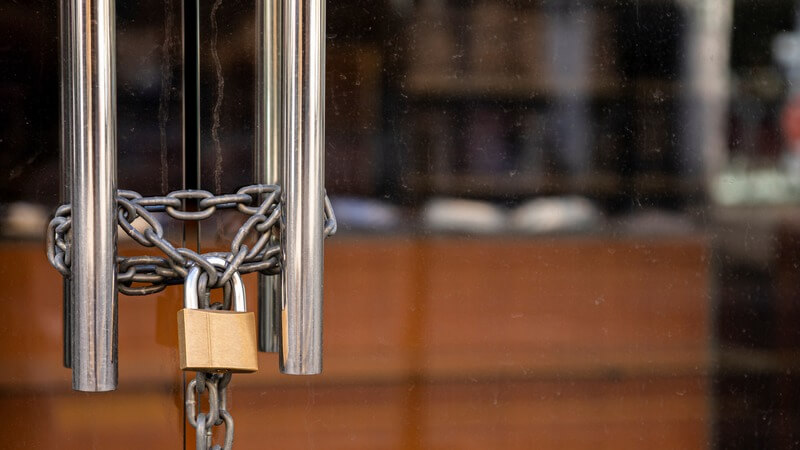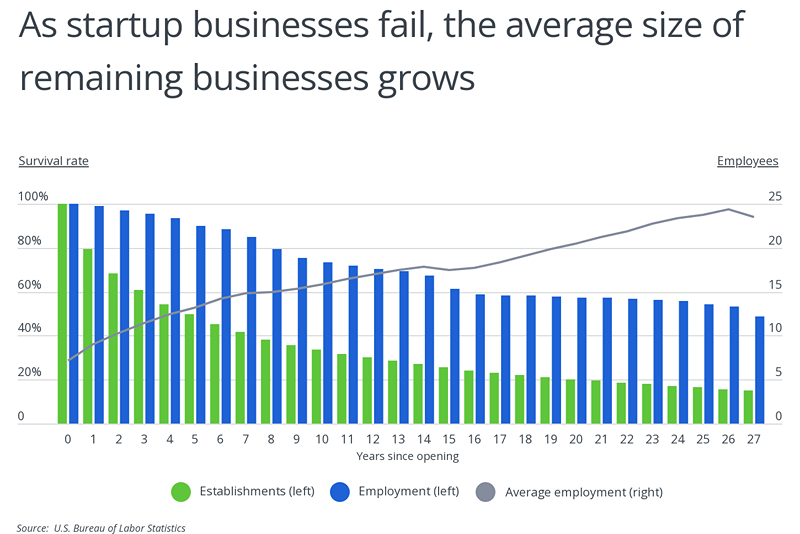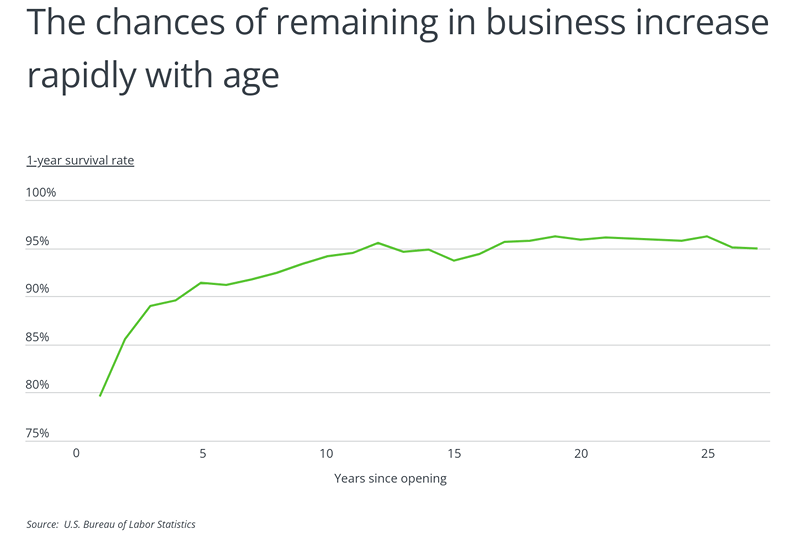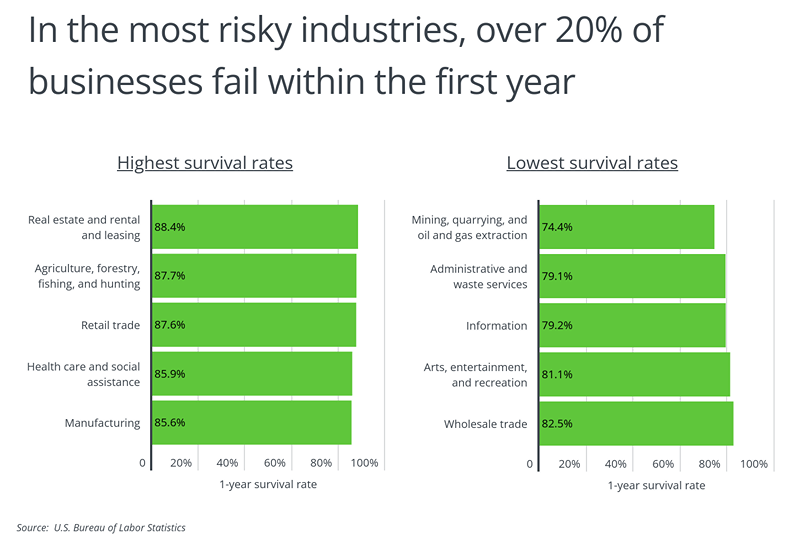The Most Risky Industries to Start a Business
 Photo Credit: ArtMediaWorx / Shutterstock
Photo Credit: ArtMediaWorx / Shutterstock
December 7th, 2022
The U.S. economy thrives on entrepreneurship and small business growth, and fortunately, new business creation has surged in recent years.
The COVID-19 pandemic and its economic effects have sparked heavy interest in entrepreneurship. Strong government stimulus and low interest rates early in the pandemic gave more entrepreneurs the resources to start new businesses. Many of the millions of workers who left their jobs in the Great Resignation have pursued new enterprises in their efforts to increase their earnings or find work better aligned with their lifestyle and interests.
As a result of these trends, official statistics demonstrated high levels of new business activity. Prior to the start of the pandemic, applications for new businesses in the U.S. averaged around 300,000 per month, but since July 2020, new business applications have exceeded 400,000 in all but two months. Projected business formations arising from new business applications are at their highest levels since before the Great Recession.

While recent economic conditions have encouraged more people to start new businesses, entrepreneurship remains an inherently risky endeavor. The chances of long-term success are fairly low: only around half of all businesses survive their first five years after opening, and only around one-third last for a decade. It's important to note though that the impact of startup closures on startup employment are not as drastic. For example, while only half of all businesses survive the first five years, more than 90% of those initially employed by a given cohort of business startups remain employed five years later. This percentage doesn't fall below 50% until nearly three decades after opening. And over time, the surviving businesses grow to employ more people.

For entrepreneurs who can stick out a business's challenging first few years, the chances of long-term survival do increase substantially. The one-year survival rate for businesses increases from 79.6% to 85.6% from the first year in business to the second and to more than 90% after the fifth. Past a decade in business, the one-year survival rate hovers around 95%.

Risk is unavoidable in any new business, but entrepreneurs in certain industries can expect greater likelihood of survival early on. Real estate and rental and leasing businesses have the highest first-year survival rates at 88.4%, which may have to do with factors like the long time horizon for real estate investments or the predictable income available from leasing and rentals. Other industries that rank highly for survival rates include agriculture, forestry, fishing, and hunting at 87.7% and retail trade at 87.6%.
On the flip side, other fields may be even riskier for new businesses than the overall average. Topping the list is mining, quarrying, and oil and gas extraction, a category that is capital-intensive, meaning they are expensive to launch and maintain, and that has volatile markets, meaning that income can be unpredictable. Businesses in mining, quarrying, and extraction have a one-year survival rate of 74.4% and a five-year survival of 41.5%—figures that are substantially lower than rates in other industries.
The data used in this report is from the U.S. Bureau of Labor Statistics. To identify the most risky industries to start a business, researchers at HireAHelper calculated a composite risk index based on the most recent one-, two-, three-, four-, and five-year survival rates for establishments in each industry.
Here are the most risky industries to start a new business.
The Most Risky Industries to Start a New Business
 Photo Credit: afotostock / Shutterstock
Photo Credit: afotostock / Shutterstock10. Construction
- Composite risk score (higher = more risk): 47.1
- 1-year survival rate: 82.9%
- 2-year survival rate: 71.8%
- 3-year survival rate: 65.4%
- 4-year survival rate: 63.6%
- 5-year survival rate: 58.6%
 Photo Credit: Zivica Kerkez / Shutterstock
Photo Credit: Zivica Kerkez / Shutterstock9. Finance and insurance
- Composite risk score (higher = more risk): 49.4
- 1-year survival rate: 84.7%
- 2-year survival rate: 73.2%
- 3-year survival rate: 64.7%
- 4-year survival rate: 61.0%
- 5-year survival rate: 56.7%
 Photo Credit: Ysbrand Cosijn / Shutterstock
Photo Credit: Ysbrand Cosijn / Shutterstock8. Arts, entertainment, and recreation
- Composite risk score (higher = more risk): 60.0
- 1-year survival rate: 81.1%
- 2-year survival rate: 70.6%
- 3-year survival rate: 63.6%
- 4-year survival rate: 62.0%
- 5-year survival rate: 57.4%
 Photo Credit: Vitpho / Shutterstock
Photo Credit: Vitpho / Shutterstock7. Transportation and warehousing
- Composite risk score (higher = more risk): 65.9
- 1-year survival rate: 83.8%
- 2-year survival rate: 68.7%
- 3-year survival rate: 61.3%
- 4-year survival rate: 61.1%
- 5-year survival rate: 53.0%
 Photo Credit: fizkes / Shutterstock
Photo Credit: fizkes / Shutterstock6. Management of companies and enterprises
- Composite risk score (higher = more risk): 70.6
- 1-year survival rate: 83.8%
- 2-year survival rate: 69.9%
- 3-year survival rate: 60.8%
- 4-year survival rate: 59.1%
- 5-year survival rate: 51.4%
 Photo Credit: iJeab / Shutterstock
Photo Credit: iJeab / Shutterstock5. Wholesale trade
- Composite risk score (higher = more risk): 74.1
- 1-year survival rate: 82.5%
- 2-year survival rate: 69.3%
- 3-year survival rate: 61.3%
- 4-year survival rate: 57.3%
- 5-year survival rate: 52.5%
 Photo Credit: SeventyFour / Shutterstock
Photo Credit: SeventyFour / Shutterstock4. Professional, scientific, and technical services
- Composite risk score (higher = more risk): 76.5
- 1-year survival rate: 82.9%
- 2-year survival rate: 69.1%
- 3-year survival rate: 60.8%
- 4-year survival rate: 58.0%
- 5-year survival rate: 52.3%
 Photo Credit: Andrey Popov / Shutterstock
Photo Credit: Andrey Popov / Shutterstock3. Administrative and waste services
- Composite risk score (higher = more risk): 89.4
- 1-year survival rate: 79.1%
- 2-year survival rate: 66.6%
- 3-year survival rate: 59.7%
- 4-year survival rate: 56.7%
- 5-year survival rate: 50.9%
 Photo Credit: Bojan Milinkov / Shutterstock
Photo Credit: Bojan Milinkov / Shutterstock2. Information
- Composite risk score (higher = more risk): 92.9
- 1-year survival rate: 79.2%
- 2-year survival rate: 65.2%
- 3-year survival rate: 56.1%
- 4-year survival rate: 54.2%
- 5-year survival rate: 48.3%
 Photo Credit: Mark Agnor / Shutterstock
Photo Credit: Mark Agnor / Shutterstock1. Mining, quarrying, and oil and gas extraction
- Composite risk score (higher = more risk): 100.0
- 1-year survival rate: 74.4%
- 2-year survival rate: 62.5%
- 3-year survival rate: 52.5%
- 4-year survival rate: 53.0%
- 5-year survival rate: 41.5%
Detailed Findings & Methodology
The data used in this report is from the U.S. Bureau of Labor Statistics Business Employment Dynamics Survey. To identify the most risky industries to start a business, researchers at HireAHelper calculated a composite risk index based on the most recent one-, two-, three-, four-, and five-year survival rates for establishments in each industry, as of March 2021.